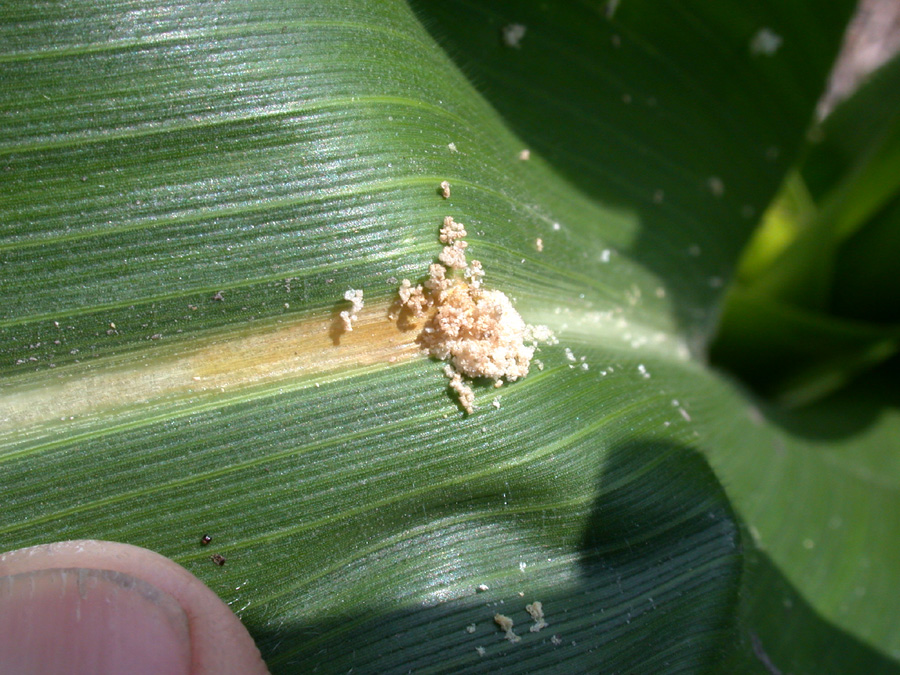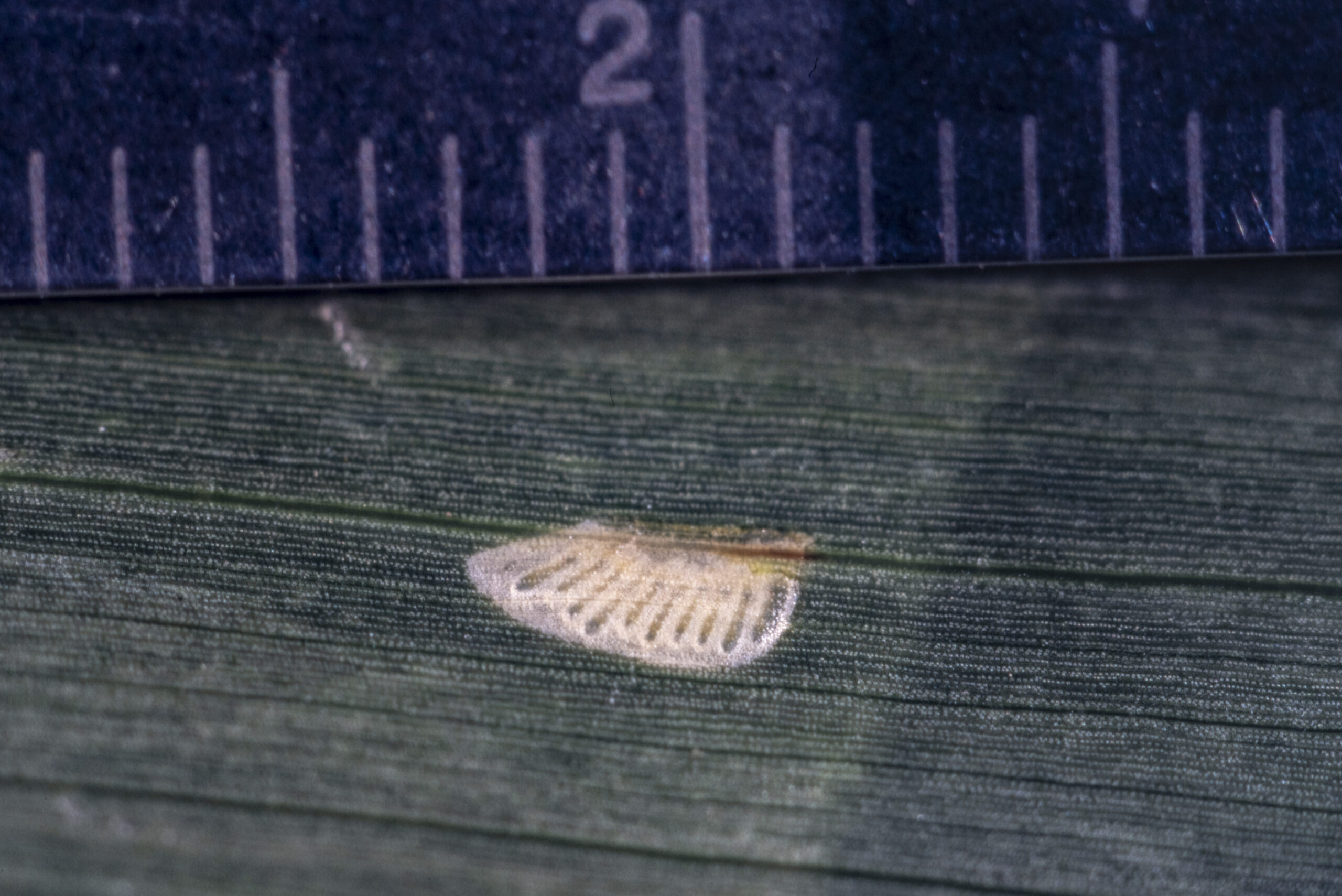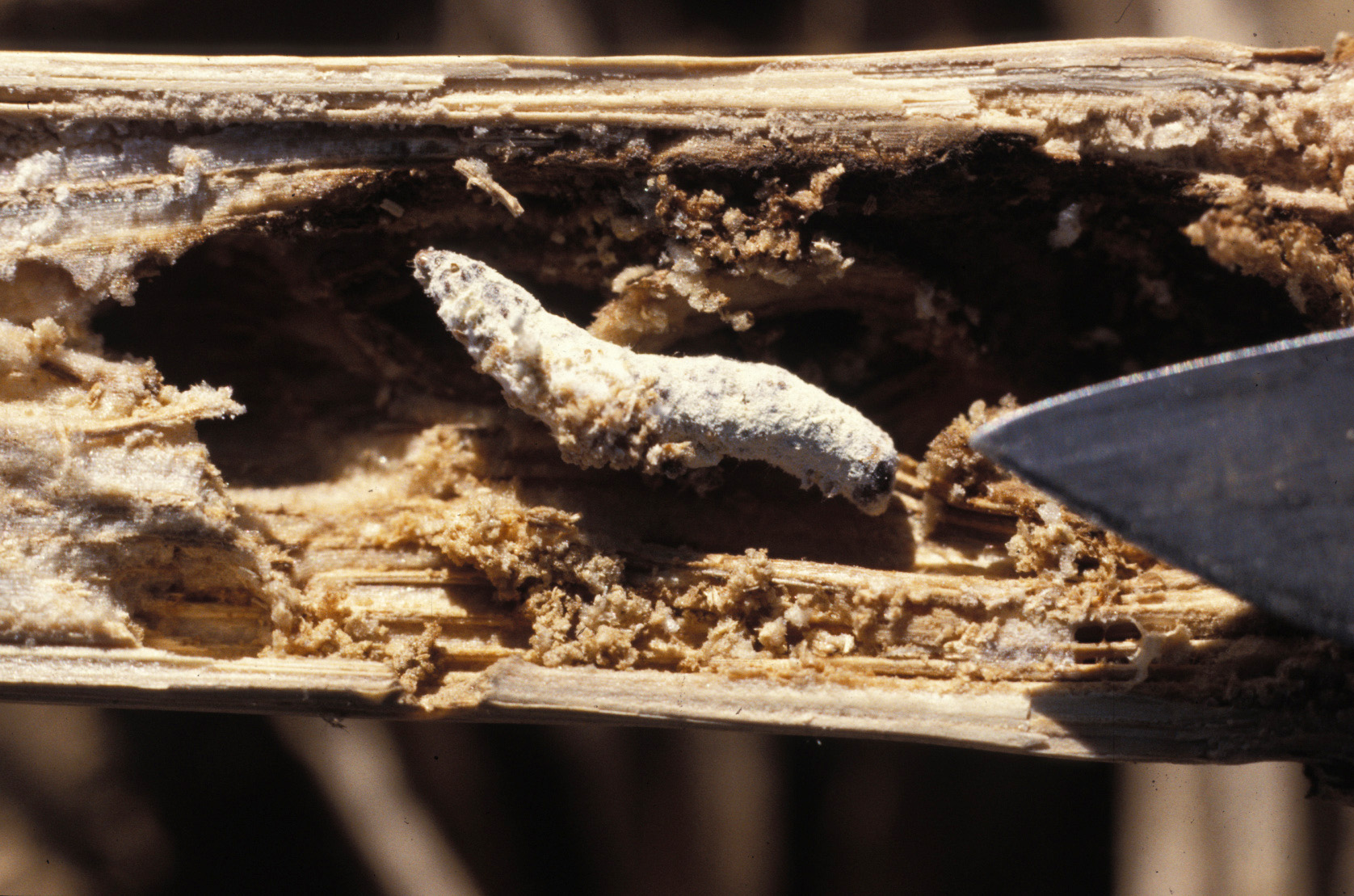European Corn BorerS (Corn)
Ostrinia nubilalis Huber
Search the Pest & Crop Newsletter
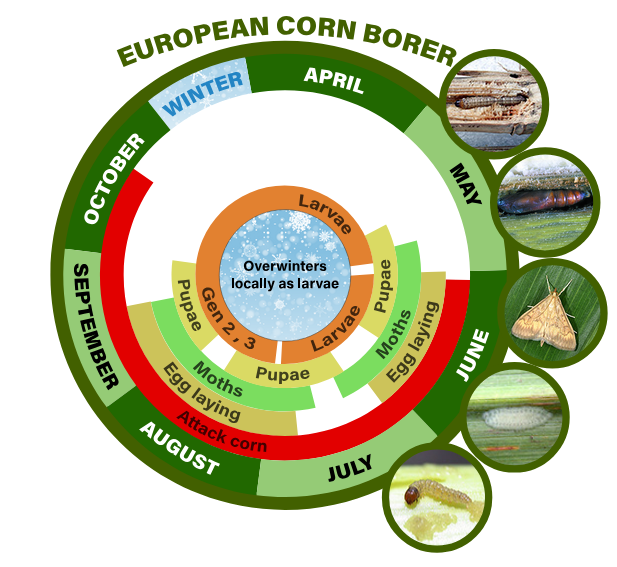
The ability to see these full-sized life-cycle images is currently disabled to resolve an issue.
Appearance and Life History
The European corn borer has been an important pest of corn in the Midwest since the 1920’s, although its pest status declined dramatically with the introduction of Bt hybrids in the late 1990’s. This approach remains effective today (2023) and few instances of resistance have been reported. Besides feeding on all types of corn, European corn borer also attacks and damages hundreds of crop and weed species (e.g., peppers, apples, soybean, cotton, foxtails, pigweeds, ragweeds, smartweeds, etc.).
The mature larva is about 1 inch (25 mm) long, creamy to grayish in color, and marked by rather inconspicuous rows of small, round, brown spots running the length of its body.
Female moths are pale yellow-brown with irregular darker bands running in wavy lines across their wings; male moths are distinctly darker and usually smaller.
Tall, lush, early planted corn is the preferred oviposition site for the first-generation moths; whereas second generation moths target actively pollinating corn, which is usually planted late.
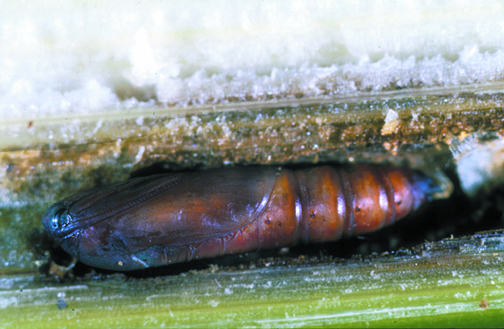
Photo by J. Obermeyer
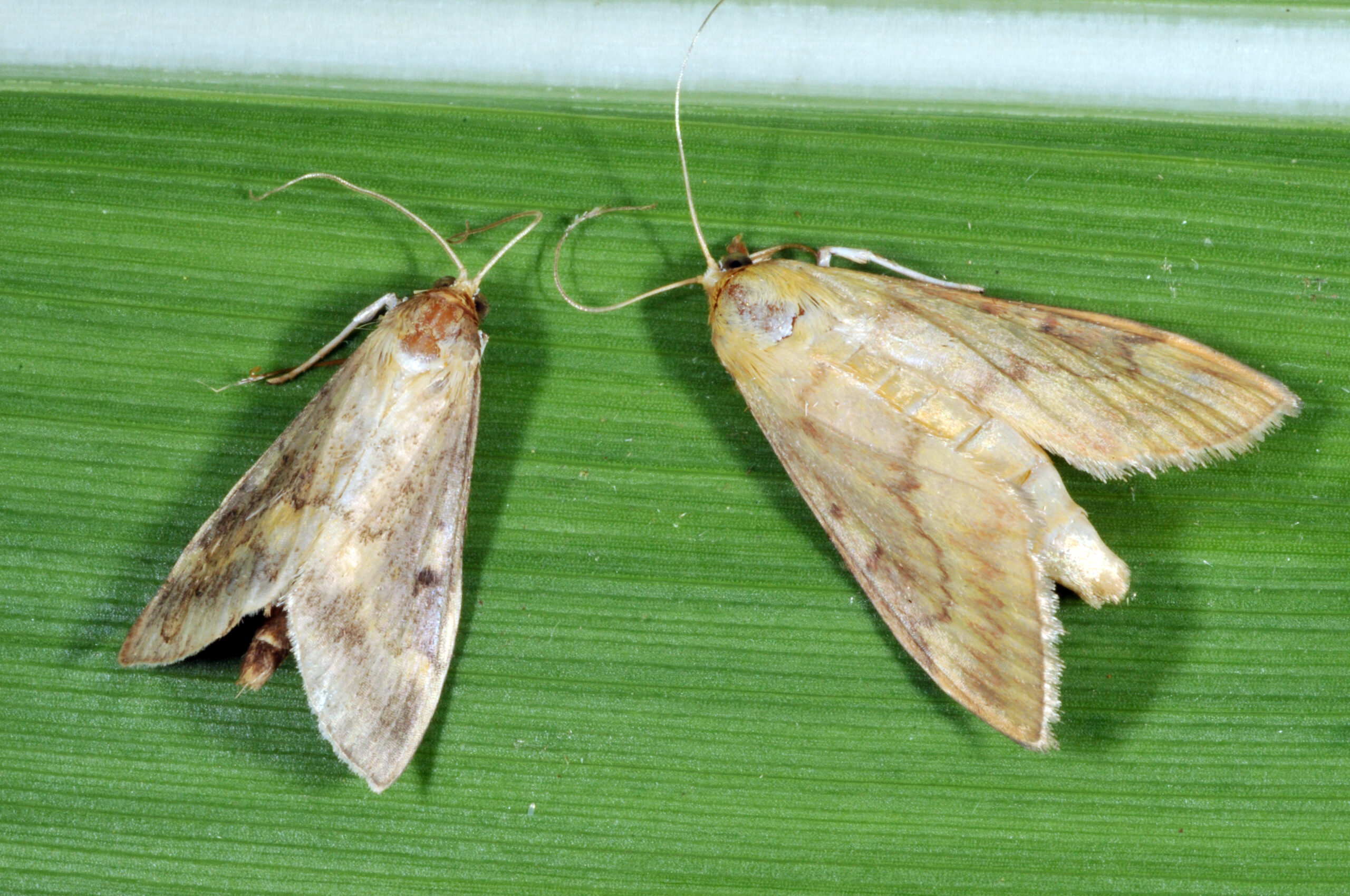
Photo by J. Obermeyer
Damage
First generation borers are usually present during June in the whorl of corn plants. As the larvae feed and grow, some may be found tunneled into the midrib of leaves, which can cause leaves to break at their point of entry. As the borers feed on the leaves, they typically produce a characteristic random or “shot hole” damage pattern. By the time the first-generation borers are half grown, they will have moved down the stalk and bored into it, leaving behind their sawdust-like excrement called frass at the stalk entry hole. Boring damage may weaken the plant, causing stalk breakage below the ear later in the season. Boring may also cause corn to become stunted, resulting in yield reductions. Stalk entry and tunneling by corn borer may predispose the plant to pathogens which can lead to stalk rots later in the season.
Second generation borers normally concentrate their attack in the ear zone, roughly the middle third of the plant. After undergoing several molts, the larvae bore into the corn plant as did the first-generation borers.
Second generation borer attack may result in stalk or tassel breakage and/or boring into the ear shanks, which may cause ears to drop off. Larvae may bore into the ears where they feed on the kernels and cob, resulting in yield losses, as well as avenues for attack from secondary insects and pathogens (e.g., ear rots). No matter where they may attack the plant, second generation borer damage can result in grain losses, harvesting problems, and poor grain quality.
Sampling Method (non-traited corn)
First Generation – Early planted corn is most likely to develop problems with first generation borers because moths are attracted to the tallest, greenest corn for egg laying.
- During June and early July when the corn is over 18 inches (45 cm) in extended leaf height, look for the characteristic “shot hole” leaf feeding damage in the whorl of the corn.
- If you do find signs of corn borer activity, sample to determine the extent of infestation.
- 5 areas of a field, 20 consecutive plants
- Examine the whorl leaves on each plant.
- Count and record the number of plants showing foliar feeding damage.
- Determine the percentage of damaged plants.
- Determine if borers are still present and actively feeding.
- Pull out, carefully unroll, and examine the whorl leaves from one plant showing damage in each sample set, for a maximum of 5 plants in the field.
- Total the number of live borers found and determine the average number of borers per plant.
Second Generation – Concentrate sampling efforts on fields that are late planted and/or actively pollinating during the period of peak egg laying. 5 areas of a field, 20 consecutive plants
- Examine each plant for egg masses and note if live larvae are present.
- Check the ear leaf and the leaves at 2 nodes above and 2 nodes below the primary ear.
- Record the number of egg masses and/or larvae found on the plants sampled.
- Determine the average number of egg masses per plant for the field and/or the average number of larvae per plant.
- Determine the percentage of plants infested.
Management Guidelines (non-traited corn)
Corn Insect Control Recommendations:
First Generation – Use the following steps to determine whether treatment is economically justified:
- Preventable yield loss (bu/A) = anticipated yield (bu/A) X yield loss figure (from following table) X level of infestation (decimal) X anticipated level of control (decimal). It is probably impractical to expect 100% control. A good estimate of control might be 75%.
- Preventable dollar loss/A = Preventable yield loss (bu/A) X market value ($/bu).
- Compare preventable dollar loss/A to cost of insecticide and application to determine if treatment is warranted.

Second Generation – Use the following steps to determine whether treatment is economically justified:
- Preventable yield loss (bu/A) = anticipated yield (bu/A) X level of infestation* (decimal) X yield loss figure** (from previous table) X anticipated level of control (decimal). It is probably impractical to expect 100% control. A good estimate of control might be 65%.
*While sampling for the second generation, consider a plant with either live larvae or egg masses as infested.
**For each egg mass, assume a survival rate of 20% (4 borers/egg mass). - Preventable dollar loss/A = Preventable yield loss (bu/A) X market value ($/bu).
- Compare preventable dollar loss/A to cost of insecticide and application to determine if treatment is warranted.
Transgenic or Bt Corn –
- Field corn producers may choose to manage corn borers through the use of Bt corn hybrids. These genetically modified corn hybrids contain a gene derived from a naturally occurring bacterium, Bacillus thuringiensis, which produces a protein that is toxic to corn borers. This eliminates the need for the application of a corn borer insecticide and reduces the need for laborious scouting for this pest, although producers should spot check areas within Bt corn fields to determine the effectiveness of this management strategy.

This leafhopper egg mass, laid slightly under the corn’s leaf surface, is often confused with the European corn borer’s eggs. However, unlike for the corn borer, this egg mass cannot be scraped off the leaf with one’s fingernail.
This overwintering European corn borer larva has been killed by the fungus Beauveria bassiana. The body appears “chalky” from the emerging fungal spores which will infect other corn borer larvae. When spring weather conditions favor this pathogen, corn borer populations can be decimated.




